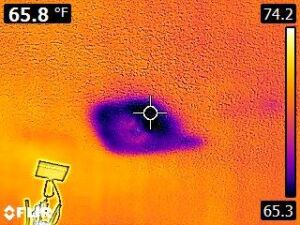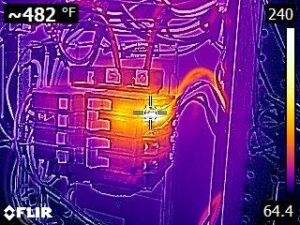
An infrared camera works by detecting and measuring the infrared energy of objects. At Nonprofit Home Inspections we use thermal imaging throughout the interior portion of our inspections to check for concerns relating to plumbing, electrical, HVAC, insulation, and more. This ancillary service provides additional insight into the functionality of otherwise inaccessible housing systems.
Plumbing leaks can be costly and often go unnoticed until the damage caused is severe. Thermal imaging can detect temperature irregularities in the ceilings, walls, and floors that can then be investigated further. When an anomaly is observed the use of a moisture meter on the affected area can confirm the presence of unwanted moisture.

The HVAC system in a home is vital for maintaining comfortability and preventing excess moisture and mold growth. Looking at the supply registers with thermal imaging can detect detached or missing ductwork. It can also locate registers that may have been covered by cabinets or flooring.
Many older homes have displaced or missing insulation in the attic or crawlspace. Thermal imaging can detect cold or hot spots in the ceiling, walls, and floor that could indicate missing insulation. Scanning these areas during the interior portion of the inspection gives inspectors clues for what to look for when entering the attic or crawlspace. Because wall interiors are inaccessible, missing insulation may never be discovered without infrared technology.
We also use thermal imaging to measure water temperature, confirm proper operation of appliances, and check for roof leaks. Because of the limitations of a general home inspection, it is not possible for an inspector to identify every defect in a home. Our use of thermal imaging is limited in scope, not exhaustive and is not a leak test. However, the use of thermal imaging combined with tools such as moisture meters, increases the likelihood that hidden issues will be discovered.
